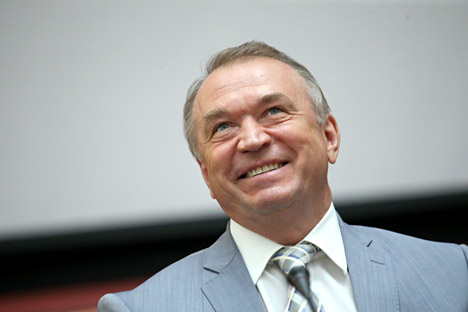
"The ruble plunge makes goods produced by Russian-based factories more competitive"
Anton Novoderezhkin/TASSWhat changes have occurred in the economic relations between Russia and the West in the past year?
There has been a significant drop in trade between Russia and most of its partners. Unfortunately, the EU and the U.S. were among the countries hit the hardest in this regard, with trade declining by 30 to 40 percent. While back in 2013, Russia’s trade with the EU was $417 billion, it dropped to $230 billion in 2015 in monetary terms. That said, in physical terms, Russia’s exports to EU countries actually increased.
Was the trade affected by the sanctions against Russia?
The current situation is due less to the Western sanctions and our own retaliatory embargo than to the fall of Russia’s GDP, the investment slowdown, the weakening of domestic demand and the plunge of the ruble.
So the sanctions have nothing to do with it all?
Their impact is secondary. The sanctions are mainly harmful in that they contaminate the atmosphere of trust that has been forming between Russia and the West for decades and point to the rise of unpredictability, which means the consumer is not sure he will be able to get the goods he ordered, and the seller does not know if he will be able to deliver it. And in case you are looking for some numbers, according to the estimates of Russia’s Ministry of Economic Development, the sanctions imposed on Russia by the EU cost the country 25 billion euro in 2015. By their calculations, this led to a 1.5 percent decrease in Russia’s GDP.
Is there any hope for the economic climate improving this year?
If someone is looking forward to a quick recovery, they have an extremely optimistic outlook. However, both Russian and Western – particularly West European – entrepreneurs are seeking to develop business relations. The companies that invest heavily in the Russian economy continue working productively here. There is no “itchy foot” sentiment whatsoever – they came to stay, and they are convinced that the Russian market will become one of the most profitable when it recovers.
Nevertheless, quite a number of foreign companies – primarily those that produce goods affected by the sanctions – have left the Russian market. The government says they will be replaced by Russian manufacturers. What is the situation like in actual practice?
The import substitution policy yielded some results for the defense industry and the agricultural sector, which seem to have already reached their pre-crisis output. The agricultural sector is doing especially well: for instance, poultry production increased by 28 percent over the last seven months. We are also seeing some signs of progress in the pharmaceuticals industry, engineering products and hydrocarbon production technologies. Still, import substitution is a long-term process and it is far too early to make any conclusions just yet.
Could you cite any examples of Russian-American or Russian-European international projects that were launched in 2015 despite the difficulties?
As numerous as the various uncertainties and risks were, business did not stand still. In September 2015, Gazprom signed an agreement with five European companies aiming to create a joint venture dubbed the New European Pipeline.
This venture will implement the Nord Stream pipeline project – we are talking about a 10 billion euro contract here. In August, the government of Finland greenlighted the process of granting building permits for the Hanhikivi-1 nuclear power station project, carried out in the west of the country and involving Russia’s Rosatom. Besides, there is the Russian-American U.S. Bell 407GXP light helicopters assembly plant in Yekaterinburg, a new electrical equipment production plant being built in Samara with the French company Schneider Electric, a pharmaceuticals factory launched in the Kaluga Region by the British company AstraZeneca and a number of other projects.
What should foreign entrepreneurs expect from Russia in 2016?
The ruble plunge makes goods produced by Russian-based factories more competitive and reduces labor, raw materials and energy costs, thus significantly decreasing the payoff time for the production of goods. So, by creating new facilities in Russia’s non-financial sector, foreign companies will be able to produce goods both for the internal and the international market. There are some examples: the European tire industry giants Nokian and Pirelli have established significant industrial presence in Russia and the goods produced by their Russian plants are selling well on the European market.
All rights reserved by Rossiyskaya Gazeta.
Subscribe
to our newsletter!
Get the week's best stories straight to your inbox